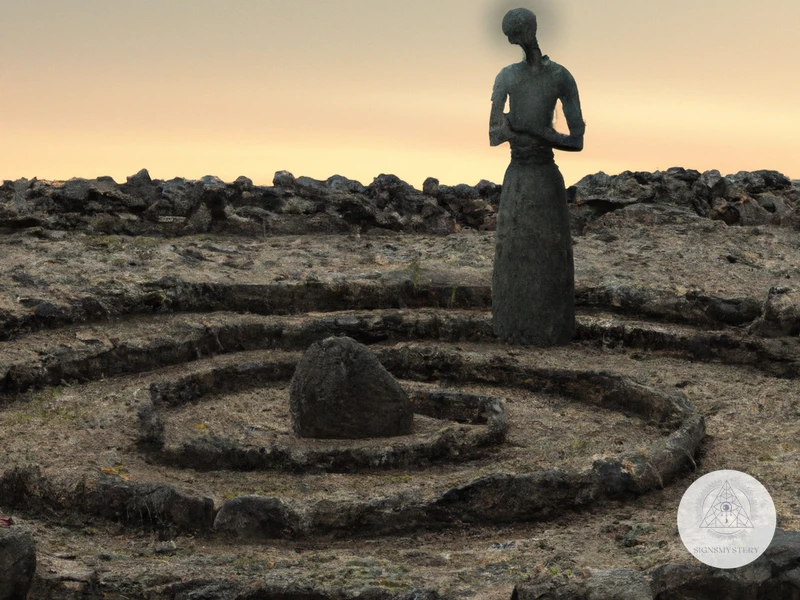In our modern, fast-paced society, people are constantly searching for ways to deepen their spiritual connections and find inner peace. One practice that has been gaining popularity in recent years is core shamanism. This alternative form of spirituality draws on ancient indigenous practices from around the world and provides a framework for self-discovery and personal growth. In this article, we will explore the basics of core shamanism, its origins and evolution, and the benefits of practicing this spiritual path. We’ll also dive into the core tenets of this practice, including journeying, merging and integration, power retrieval, shamanic healing, and divination. Finally, we’ll examine the modern-day significance of core shamanism in addressing psycho-spiritual challenges, connecting with nature and spirit, unleashing the power of self-healing, and enhancing creativity and intuition.
What is Shamanism?
Shamanism is one of the oldest spiritual practices known to humankind, dating back more than 40,000 years. It is a practice of connecting with the spiritual world, the natural world, and oneself, in order to gain wisdom, healing, and guidance. In shamanic cultures, shamans were revered as spiritual leaders and healers who had the ability to connect with the unseen world or the spirits of nature for the benefit of the community.
Shamanism is still practiced in many parts of the world today, including South America, Africa, and Asia. In recent years, there has been a growing interest in shamanism in the Western world due to its emphasis on personal empowerment, self-discovery, and spiritual growth.
One of the core beliefs of shamanism is that everything in the universe is imbued with spirit, and that all things are connected. Through shamanic practices, individuals can learn to interact with these spirits, and gain insight and knowledge that can benefit their lives.
Shamanism involves a range of practices, including meditation, ritual, and the use of symbolic objects such as drums, feathers, and crystals. However, shamanic practices can vary widely depending on the culture and tradition in which they are practiced.
In core shamanism, which is a contemporary form of shamanism developed by anthropologist Michael Harner, there are a set of basic practices that can be used by individuals from any cultural background to connect with the spiritual world. These practices are designed to be accessible and adaptable, and do not require the use of culturally specific rituals or objects.
Some of the core practices of core shamanism include journeying, which involves traveling to the inner world to connect with one’s spiritual guides and allies, and the use of power animals as sources of guidance and support. Other practices include divination, shamanic healing, and power retrieval, which involves reclaiming lost personal power.
While shamanism has ancient roots, it has remained relevant in modern times due to its ability to help individuals connect with their inner selves and the natural world. In the next sections, we will explore the basics of core shamanism and its significance in the modern world.
Defining Core Shamanism
Core Shamanism is distinguishable from other modern forms of shamanism due to its emphasis on universal shamanic practices that have been identified cross-culturally in indigenous societies globally. It was established by the renowned anthropologist and shamanic practitioner, Michael Harner, in 1980 as a way to revive and perpetuate shamanism in the West.
The concept behind Core Shamanism centers on the belief that all humans have the ability to connect to the spirit world and can access it through shamanic techniques. Since Core Shamanism is not based on any particular cultural or religious traditions, it is accessible to people of all beliefs and backgrounds.
Harner identified several core practices which are common throughout shamanic cultures worldwide. These include journeying, power animal retrieval, and soul retrieval, which are central to Core Shamanism. These practices enable individuals to connect with the spiritual world, work with spirit guides and allies, retrieve power, retrieve lost soul parts, and experience spiritual healing.
Journeying, a key practice in Core Shamanism, involves entering an altered state of consciousness to connect with spirit allies or explore spiritual realms for guidance, understanding, and healing. This journey is facilitated through drumming or rattling, which allows the participant to enter a trance-like state. Shamanic drumming creates a sonic pattern that helps align the physical body and psyche to the frequency of the spiritual world.
Power animal retrieval is another essential practice in Core Shamanism. It centers on the belief that every person has a spirit animal that acts as a guardian and guide. Through shamanic drumming and journeying, one can connect with their power animal and tap into their innate power and wisdom. Power animals are seen as allies and helpers that provide direction and support throughout our spiritual and physical lives.
Soul retrieval is a method of shamanic healing that is frequently used in Core Shamanism. It deals with the concept of soul loss, which is the loss or fragmentation of the soul that can occur after traumatic experiences. The shaman connects with the spirit world using journeying, and with the help of a spiritual guide, retrieves lost soul parts to reintegrate them into the person’s psyche. This results in emotional growth and a sense of being more whole.
Core Shamanism is an accessible form of shamanism available to people of all backgrounds. It is based on universal shamanic practices, not any specific culture or tradition. Through practices such as journeying, power animal retrieval, soul retrieval, and other techniques, individuals can connect with the spiritual world and experience personal growth, healing, and spiritual awakening.
Origins and Evolution of Core Shamanism
Core shamanism is a modern method of shamanism that was developed by anthropologist Michael Harner in the 1980s. Harner studied ancient shamanic practices from around the world and identified the commonalities among them, creating a streamlined and effective method of shamanism that anyone can learn and practice.
Harner’s interest in shamanism grew out of his earlier work with the Conibo people in the Peruvian Amazon. He discovered that their shamanic practices went beyond the traditional Western understanding of religion and offered unique insights into the nature of reality. This inspired him to seek out other shamanic traditions from around the world and to develop a new method of shamanic practice that could be utilized by anyone.
Over time, core shamanism has evolved and expanded to include elements from a wide range of shamanic traditions, including those of the Native American, Celtic, and Siberian peoples. Today, core shamanism is recognized as a highly effective and accessible form of spiritual practice that can offer profound healing and personal growth.
In addition to Michael Harner’s work, other scholars and practitioners have contributed to the evolution of core shamanism. For example, Sandra Ingerman, a shamanic practitioner and teacher, has developed a form of ethical core shamanism that emphasizes the importance of working with integrity and respect for all beings.
The origins and evolution of core shamanism reflect a growing interest in ancient spiritual practices and a desire to connect with the deeper forces of the universe. By drawing on the wisdom of shamanic traditions from around the world, core shamanism offers a powerful and transformative path for those who seek to explore the mysteries of the soul.
Benefits of Practicing Core Shamanism
Practicing Core Shamanism offers a wide range of benefits that can positively impact the body, mind, and soul. From healing physical ailments to addressing emotional and spiritual imbalances, practicing Core Shamanism can help individuals attain a greater sense of well-being and connection with the natural world. Here are some of the key benefits of practicing Core Shamanism:
1. Stress Relief: Core Shamanism practices are known to reduce stress and promote relaxation. Shamanic journeying, in particular, can help individuals access deeper states of consciousness that can facilitate a sense of calm and inner peace.
2. Increased Self-Awareness: Core Shamanism practices can help individuals tap into their inner selves, helping them uncover deeper truths and insights about themselves and the world around them. By exploring the inner realms of consciousness, individuals can better understand their thoughts, feelings, and motivations.
3. Emotional Healing: Core Shamanism can address emotional issues and help individuals release past traumas and negative emotions. Shamanic practices such as power retrieval and soul retrieval can help individuals reclaim lost parts of themselves and heal deep-seated emotional wounds.
4. Connection to Spirit: Core Shamanism can help individuals form a deeper connection with the spiritual world, providing a sense of purpose and meaning in life. By connecting with spirit guides and other spiritual entities, individuals can gain insight into their life path and discover their true purpose.
5. Physical Healing: Core Shamanism can also help in addressing physical ailments and pain. Shamanic practices like extraction can help remove negative energies that may be contributing to physical symptoms.
Practicing Core Shamanism can offer individuals a multitude of benefits that can positively impact their physical, emotional, and spiritual well-being. It is a powerful tool for self-discovery, healing, and connecting with the natural world.
The Basic Tenets of Core Shamanism
Journeying: A cornerstone of Core Shamanism is the practice of journeying. Journeying involves shifting your consciousness to reach other levels of reality, such as the spirit world, to gain insight and to heal. During a journey, the shamanic practitioner drum or rattles to induce an altered state of consciousness. The journeyer then travels to these other worlds to receive guidance, knowledge, and healing from their helping spirits.
Merging and Integration: Another important tenet of Core Shamanism is the concept of merging and integration. This is the process of building a relationship with a spirit helper by merging your spirit with the spirit of the helper, allowing it to offer guidance and wisdom. This process is fundamental to shamanic practice and often occurs during journeying.
Power Retrieval: The shamanic practitioner undergoes power loss due to traumatic events, spiritual pollution, or soul loss. Power retrieval involves the process of locating and obtaining lost power to restore balance. The shamanic practitioner, with the help of their spirit helpers, can retrieve lost power by seeking it out in the spirit world.
Shamanic Healing: The process of shamanic healing involves the recognition and elimination of negative energy patterns, disharmonious emotions, and spirit attachments that may affect our physical, emotional, or mental well-being. This process involves balancing the body, mind, spirit, and emotions, typically done through hands-on techniques that could include massage, use of herbs, and sound healing.
Divination: Divination is an essential part of Core Shamanism. The shamanic practitioner may use a number of tools, such as oracle cards or divination stones, to gain insight into a situation or to offer guidance. Divination is also done with the help of spirit helpers, who provide guidance and answers to questions asked by the practitioner. It is conducted with the deepest respect and intention to bring beneficial results.
By practicing these basic tenets, a Core Shamanic practitioner gains sufficient healing energy to help not only oneself but also others in need, including animals, plants, and the environment. At the same time, the shamanic practitioner might experience broadening their consciousness and deepening their connection to the earth and the divine powers of the universe.
Journeying
is a crucial tenet of Core Shamanism. It is a technique that allows practitioners to enter into a state of consciousness where they can connect with spirit helpers and receive guidance and wisdom from the spiritual realm. Journeying involves accessing an altered state of consciousness, through drumming, rattling, or meditation, to travel to non-ordinary reality. In this realm, a shaman can connect with spirit guides, power animals, and other spiritual entities.
During the journey, the shaman can ask for guidance, information, or healing for themselves or others. They can also gain insight into their lives and make decisions based on the messages or visions they receive. Journeying is similar to lucid dreaming, where the dreamer is aware that they are dreaming and can control their actions in the dream world.
The journeying can be done in groups or alone. However, it is recommended that beginners start with a trained practitioner to assist and guide them. Journeying often involves overcoming obstacles, such as a journey in a dark forest or a journey over a harsh landscape.
One of the most significant benefits of journeying is the ability to gain personal power and knowledge. Through contact with spiritual entities, a shaman can gain insight into their own lives and find answers to their problems. Journeying allows one to tap into their inner wisdom, as well as connect with wisdom from the spiritual world.
Journeying is one of the most important practices in Core Shamanism, allowing the shaman to connect with spirit helpers and to access guidance and wisdom beyond the physical world. With practice, journeying can provide profound insights and experiences that lead to spiritual growth and personal empowerment.
Merging and Integration
Merging and Integration are two of the most important tenets of Core Shamanism. Merging refers to the ability of the shaman to merge with spiritual beings, animals, or other entities to gain insight, wisdom, and power from them. Integration refers to the process of incorporating these entities or qualities into oneself to achieve greater balance and harmony.
One way that merging is practiced in Core Shamanism is through the use of power animals. A power animal is a spiritual helper that takes the form of an animal and provides guidance and protection to the shaman. Power animals are believed to possess qualities that the shaman may need to enhance within themselves. For example, if the shaman needs strength and endurance, they may merge with a bear. If they need clarity of vision, they may merge with an eagle.
Integration, on the other hand, involves taking on the qualities of these entities and making them a part of oneself. This can involve physical postures or movements, vocalizations, or visualization techniques. One common example of integration is the practice of “becoming the tree.” The shaman visualizes themselves as a tree, rooting deeply into the earth and reaching up to the sky. Through this process, they incorporate the qualities of stability, growth, and connection with nature into themselves.
Another way that merging and integration are used in Core Shamanism is through the practice of soul retrieval. Soul retrieval involves the shaman journeying into the spiritual realm to retrieve parts of a person’s soul that have been lost due to trauma, illness, or other causes. Through the process of merging with these soul parts and integrating them back into the person, the individual can experience profound healing and wholeness.
Merging and integration are essential practices in Core Shamanism that allow the shaman to gain wisdom and power from spiritual entities and incorporate these qualities into themselves for greater balance and harmony. Whether through the use of power animals, physical movements, or soul retrieval, these practices can lead to profound personal growth and healing.
Power Retrieval
is a core shamanic practice that involves restoring power to an individual or a group. According to shamanic belief, power loss is a common cause of many problems in life and can be caused by a variety of sources, such as trauma, illness, anger, grief, or a lack of purpose.
During a Power Retrieval session, a shamanic practitioner enters a trance state and journeys to the spirit world to locate and retrieve the lost power. The shamanic practitioner may call upon a power animal or spirit guide to assist in this process.
Once the lost power is found, the shamanic practitioner brings it back to the client and helps them to integrate it back into their being. The restored power can lead to a greater sense of energy, vitality, and inner strength, and can help individuals overcome challenges and move forward in their lives.
Here are some of the benefits of a Power Retrieval:
- Increased energy and motivation
- Greater sense of purpose and direction
- Improved self-esteem and confidence
- Enhanced physical health and well-being
- Deeper connection to one’s authentic self
It is worth noting that Power Retrieval is not a substitute for traditional medical or psychiatric treatment. However, it can complement these treatments and offer a source of support and guidance for individuals on their healing journey.
Power Retrieval is a powerful tool for restoring lost energy and power and can help individuals overcome obstacles and find greater meaning and purpose in life.
Shamanic Healing
Shamanic Healing is one of the core practices of Core Shamanism, which is often used to address a wide range of physical, emotional, and spiritual ailments. It involves meeting with spiritual guides or power animals and accessing the spiritual realm to remove blockages, restore balance and harmony, and promote self-healing.
One of the key aspects of Shamanic Healing is the belief that every person has a natural ability to heal themselves. The shamanic healing process serves as a catalyst for individuals to unleash their innate ability to self-heal. By connecting with the spiritual realm, the shamanic healer can identify and address the root cause of the individual’s ailment, which may be physical, emotional, or spiritual in nature.
There are many techniques used by shamanic healers to access the spiritual realm and facilitate the healing process. One such technique is soul retrieval, which involves retrieving lost parts of an individual’s soul that may have been lost due to trauma or negative experiences. The shamanic healer may also use an extraction technique, where they remove negative energy or blockages from the individual’s energy field.
Another important aspect of Shamanic Healing is the use of energy medicine. This involves working with the individual’s energy system and chakras to promote balance and harmony. The shamanic healer may use various tools such as crystals, sound therapy, or herbs to facilitate the flow of energy and enhance the healing process.
Shamanic Healing may also involve working with the individual’s ancestors or spirit guides. These spiritual entities serve as guides and helpers, providing insight and guidance to the shamanic healer and individual during the healing process.
Shamanic Healing is a powerful practice that can help individuals to overcome physical, emotional, and spiritual ailments. It involves accessing the spiritual realm and working with spiritual guides and power animals to promote self-healing. There are various techniques and tools used by shamanic healers to facilitate the healing process, including soul retrieval, energy medicine, and communication with spiritual entities.
Divination
is the practice of seeking knowledge of the future or the unknown through supernatural means. In Core Shamanism, divination is an essential tool for guiding a person through their journey and providing insight into their spiritual path.
There are various methods of divination used by Core Shamans, including the use of tarot cards, rune
Subscribe to Our Newsletter
Sign up to receive the latest news and updates.
During a shamanic journey, a person enters a state of trance where they can achieve an altered state of consciousness. Once in this state, they connect with their spirit guides and ancestors who can provide insight into any issue or question that the person seeking guidance may have.
Divination can help an individual gain clarity on a situation, make better decisions, and move forward on their spiritual journey. Using divination as a tool is especially helpful when feeling lost or confused about life’s purpose.
It is important to note that divination is not used to predict the future with 100% accuracy but is meant to provide guidance based on the current situation and path a person is on. It is up to the individual to use the knowledge gained from divination to create their future.
In summary, divination is a vital aspect of Core Shamanism, providing guidance and insight for those on their spiritual journey. It is a powerful tool that should be used with respect and intention to gain clarity and direction.
The Significance of Core Shamanism in Modern Times
The practice of Core Shamanism has re-emerged as a vital tool for coping with the spiritual, emotional, and psychological challenges of modern life. Its significance lies in its ability to provide holistic and natural solutions for addressing various problems that modern lifestyle poses to human wellbeing. Here are some of the ways in which the practice of Core Shamanism can be significant in modern times:
In modern times, there is an increasing trend towards spirituality and healing practices that complement traditional medicine. Core Shamanism offers a unique combination of traditional and modern techniques that can be tailored to cope with different psycho-spiritual challenges such as anxiety, addiction, depression, and trauma. By tapping into the profound wisdom of the spirits and connecting with one’s higher self, Core Shamanism helps individuals attain inner peace, self-awareness, and purpose in life.
In a society that is increasingly disconnected from nature and consumed by materialism, Core Shamanism emphasizes the significance of our relationship and connection with the natural world. Through shamanic practices such as journeying and power retrieval, individuals can reconnect with nature and develop profound relationships with spirit animals and totems that offer guidance, protection, and healing.
Core Shamanism offers individuals the tools for self-healing by tapping into their own innate healing powers. By connecting with their spiritual guides and teachers, individuals can access their “inner pharmacy,” where they can find their own unique remedies and healing modalities to overcome a wide range of ailments and health conditions.
Shamanic practices can awaken an individual’s creativity and intuition by helping them cultivate an open and receptive state of mind. By accessing the realm of non-ordinary reality, individuals can find inspiration, clarity, and new perspectives on everyday life situations. This can lead to a deeper understanding of oneself and others, and ultimately to greater creativity, innovation, and problem-solving ability.
The significance of Core Shamanism in modern times lies in its ability to offer people a unique and profound way of addressing the spiritual, emotional, and psychological challenges of modern life. By tapping into the wisdom of the spirits and cultivating a deeper connection with nature, individuals can find their own sources of healing, meaning, and purpose in life.
Addressing Psycho-Spiritual Challenges
At the core of Core Shamanism lies the ability to address psycho-spiritual challenges that plague modern society. These challenges include anxiety, depression, addiction, and other mental health issues that are often a result of disconnection from the spiritual world. By connecting with the spiritual world through shamanic practices, one can find a sense of purpose and fulfillment that can alleviate these challenges.
One way in which Core Shamanism can address psycho-spiritual challenges is through journeying. Journeying allows individuals to connect with their inner selves and explore the root causes of their issues. By doing so, they can gain a deeper understanding of their struggles and find ways to overcome them.
Merging and integration is also a core tenet of Core Shamanism, which can help individuals to address psycho-spiritual challenges. By merging with an animal spirit or guide, individuals can gain insights into their own psyche and find new ways of looking at their problems. This can lead to a greater sense of clarity and direction, which can be invaluable in the process of healing.
Power retrieval is another important concept in Core Shamanism, which involves reclaiming lost energy or power that can be used to overcome psycho-spiritual challenges. By working with a shamanic practitioner, individuals can retrieve lost power and use it to heal themselves or others.
Overall, Core Shamanism is a powerful tool for addressing psycho-spiritual challenges. Its emphasis on spiritual connection and exploration can provide individuals with a sense of purpose and fulfillment, which can help them to overcome the challenges that they face in their lives. If you are struggling with mental health issues or other psycho-spiritual challenges, consider exploring the world of Core Shamanism to find the healing and guidance that you need.
Connecting with Nature and Spirit
Core shamanism emphasizes the importance of connecting with the natural world and the spiritual realm. This technique can lead to numerous benefits, including a better understanding of oneself and the world around us.
As humans, we often forget that we are not separate from the natural world. Instead, we are a part of it, and this connection can help us feel more grounded and at peace. By connecting with nature, we can tap into the wisdom it offers and unlock our intuitive abilities.
Shamans believe that everything in the natural world has a spirit, and by connecting with these spirits, we can gain insight into ourselves and our lives. The natural world is full of symbolism and messages, which can help us better understand our place in the world and the journey we are on.
Spiritual connection is also crucial in core shamanism. By accessing the spiritual realm through journeying and other shamanic practices, we can gain knowledge and wisdom that can guide us through life. This connection can help us to feel a sense of purpose and belonging, and can also lead to a greater understanding of our place in the world.
Through spiritual connection, we can also tap into our innate creativity and intuition. By accessing the spiritual realm, we can connect with our higher selves and unlock our full potential. This can lead to a deeper sense of fulfillment and happiness in life.
Connecting with nature and spirit is a fundamental part of core shamanism. By embracing this philosophy and integrating it into our daily lives, we can tap into the inherent wisdom of the natural world and unlock our full potential as human beings.
Unleashing the Power of Self-Healing
One of the most significant benefits of practicing Core Shamanism is that it empowers us to unleash our innate power of self-healing. This form of shamanism recognizes that each of us has a natural ability to heal ourselves, and it provides us with the tools to cultivate and activate this ability.
Core Shamanism believes that healing is a natural process that occurs when we align ourselves with the natural order of the universe. Shamanic practitioners believe that health is not simply the absence of disease, but rather a state of balance and harmony between the physical, emotional, and spiritual aspects of being.
By learning to journey, merge with spirit guides and power animals, and use shamanic techniques such as power retrieval and soul retrieval, we can embark on a journey of self-discovery and self-healing. We can learn to identify and address the root causes of our physical and emotional ailments, and we can tap into our internal resources to promote healing and balance.
One important aspect of self-healing in Core Shamanism is learning to work with our energy centers or chakras. Chakras are the centers of spiritual power in the body, and they are associated with different emotions, organs, and systems. In Core Shamanism, practitioners use techniques such as chakra clearing and balancing to remove blockages and restore the natural flow of energy throughout the body, promoting better health and well-being.
Another powerful tool for self-healing in Core Shamanism is working with the elements of nature. Shamanic practitioners believe that nature is our greatest teacher and healer, and that by connecting with the natural world, we can receive guidance and support in our healing journey. By spending time in nature, practicing gratitude and mindfulness, and learning to tap into the wisdom of the elements, we can unleash the power of self-healing and achieve greater levels of health and well-being.
The power of self-healing in Core Shamanism lies in its ability to awaken our innate ability to heal ourselves. It empowers us to take charge of our own health and well-being, and to tap into the natural healing resources within us and around us. Through a regular shamanic practice, we can cultivate this power and use it to achieve greater levels of balance, harmony, and vitality in our lives.
Enhancing Creativity and Intuition
Core shamanism can be a powerful tool for enhancing creativity and intuition. Through shamanic journeying, one can escape the confinements of the rational mind and connect with the deeper recesses of the psyche, where the well-spring of inspiration lies. By tapping into the subconscious, one can access a vast array of symbolic imagery and archetypes that can fuel the creative process and offer insights into one’s life path.
Shamanic practices can help one attune to the rhythms of nature and the cosmos, which can enrich one’s sense of aesthetics and cultivate a more intuitive approach to creative expression. Nature is a boundless source of beauty and wonder that can inspire art, music, writing, and other forms of creativity. By communing with nature through shamanic practices like shamanic journeying, one can gain a deeper appreciation of the natural world and learn from its organic forms and patterns.
Additionally, core shamanism can help one develop and trust their intuition. The modern world often undervalues intuition and emphasizes logical, left-brain thinking. However, intuition is a vital aspect of human perception and can be honed through shamanic practices like journeying and divination. By learning to tune into one’s inner voice and the signs and symbols that arise in shamanic journeys, one can gain greater clarity and insight into their life path and creative endeavors.
Core shamanism offers a unique and potent way to enhance creativity and intuition. Through shamanic practices like journeying and divination, one can tap into the mysterious realms of the psyche, commune with nature, and cultivate a more intuitive perception of the world. With these tools at our disposal, we can unlock the boundless potential of the human imagination and create a more harmonious and inspired world.
Conclusion
It is evident that Core Shamanism is more than just a set of techniques and practices that have been adapted for modern times. It represents a way of life that is deeply connected to the natural world, the spirit realm, and one’s own inner being. By practicing the basic tenets of Core Shamanism which include journeying, merging and integration, power retrieval, shamanic healing, and divination, one is able to tap into a wellspring of spiritual and creative energy.
As we have seen, Core Shamanism holds immense significance in modern times. It provides a holistic approach to addressing psycho-spiritual challenges, connecting with nature and spirit, unleashing the power of self-healing, and enhancing creativity and intuition. By doing so, it helps individuals to live more fulfilling and authentic lives, and to contribute positively to their communities and the world at large.
It is important to note that while Core Shamanism is accessible to everyone, it requires dedication, patience, and an open mind. It is not a quick fix or a one-size-fits-all solution, but rather a lifelong journey of learning and self-discovery. Those who choose to embark on this path should do so with a sense of reverence, humility, and respect for the wisdom and guidance of the spirits.
In the end, what makes Core Shamanism so powerful and transformative is not just its techniques or teachings, but the deep sense of interconnectedness and meaning that it brings to one’s life. It offers a way of living that is in harmony with the natural world, the spirit realm, and one’s own soul. So, whether you are a seasoned practitioner or just starting on your path, may you find strength, guidance, and inspiration in the wisdom of Core Shamanism, and may you use it to unlock your true potential and bring healing and transformation to those around you.
Frequently Asked Questions
What is a shaman?
A shaman is a person who has the ability to communicate with the spirit world and perform healing and other rituals on behalf of their community.
What is the difference between traditional shamanism and core shamanism?
While traditional shamanism is tied to specific cultural practices and beliefs, core shamanism is a universal practice that focuses on accessing and working with the core elements of shamanism that are common to all cultures.
What are the basic tenets of core shamanism?
The basic tenets of core shamanism include journeying, merging and integration, power retrieval, shamanic healing, and divination.
What is journeying in core shamanism?
Journeying involves entering an altered state of consciousness through drumming or other techniques in order to communicate with spirits and receive guidance or healing.
What is merging and integration?
Merging and integration involves connecting with and fully embodying spirit helpers or power animals in order to gain their energy and knowledge.
What is power retrieval in core shamanism?
Power retrieval involves recovering parts of the self that have been lost or disconnected through trauma or other life experiences.
What is shamanic healing?
Shamanic healing involves working with spirits to address physical, emotional, and spiritual imbalances through a variety of techniques, including soul retrieval and extractions.
What is divination in core shamanism?
Divination involves using shamanic techniques to communicate with spirits and receive guidance or insight into a situation or issue.
How can practicing core shamanism benefit individuals?
Practicing core shamanism can offer benefits such as addressing psycho-spiritual challenges, connecting with nature and spirit, unleashing the power of self-healing, enhancing creativity and intuition, and facilitating personal growth and transformation.
Are there any risks to practicing core shamanism?
While core shamanism is generally considered safe, individuals should approach the practice with caution and respect for the spirits and techniques involved. It’s important to work with a qualified shaman or practitioner and be aware of the potential for psychological or emotional upheaval during the healing process.










